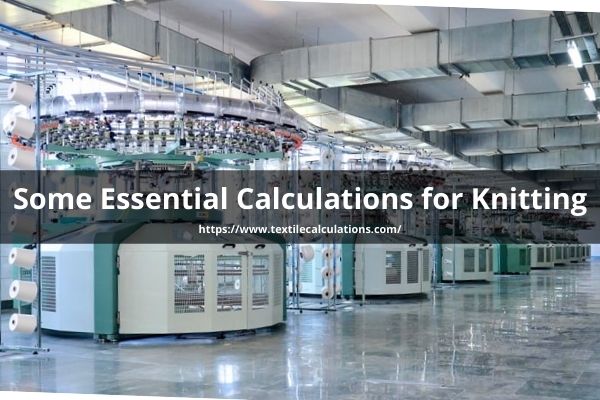Introduction:
Knitting is a process of creating fabric or textile by interlocking loops of yarn or thread using two or more needles or a machine. The two most common types of knitting are hand knitting and machine knitting. Knitting is a versatile and flexible process that can be used to create a wide range of products, including clothing, accessories, home furnishings, and industrial textiles.
Knitting is a completely calculation based production. Before production, any item knitter must calculate first. If calculation is done perfectly then production efficiency will increase. Now I’m giving some problems of knitting for helping purpose novice knitting muster. In a previous article, I have written about the different necessary formula for knitting. You can read the followings essential calculations for knitting to understand the following problems.

Some Essential Calculations for Knitting
Calculations for Knitting
Problem-1: Calculate the production per hour (in gauge) of a circular knitting machine from the following data –
- Cylinder dia – 30”
- Cylinder speed – 20 rpm
- No. of feeder – 36
- Efficiency – 80%
- Course/inch – 30
- Course/rpm – 36
Solution:
Given,
- Cylinder dia – 30”
- Cylinder speed – 20 rpm
- No. of feeder – 36
- Efficiency – 80%
- Course/inch – 30
- Course/rpm – 36
- Production/8 hour =?
We know that,
Course/min = No. of feeder X Cylinder speed
= 36 X 20
= 720
Again,
……………………..Course/min
Production = ………………………. X Efficiency
……………………..Course/inch
= (720/30) X (80/100) inch/min
= (720/30) X (60/30) X (80/100) gauge/hr
= 32 gauge (ANS)
Problem-2: Calculate the production per 8hr (in meter) of a circular knitting machine from the following data –
- No. of feeder – 48
- Fabric width – 264 cm
- Stitch density – 15
- Machine speed – 20 rpm
- Gauge – 14
- Efficiency – 75%
Solution:
Given,
- No. of feeder – 48
- Fabric width – 264 cm
- Stitch density – 15
- Machine speed – 20 rpm
- Gauge – 14
- Efficiency – 75%
- Production/8hr =?
We know that,
…………………..No. of Wales in fabric…………Gauge X π X Dia
Wales/cm = …………………………………… = ………………………………
………………………Width of fabric…………………Width of fabric
= (14 X 3.14 X 30)/264 = 4.995 = 5
Again,
Course/cm = (Stitch density)/(Wales/cm) = 15/5 = 3
……………………..Course/min…………………………No. of feeder X m/c speed
Production = …………………….. X Efficiency = ………………………………………..X Efficiency
………………………Course/cm……………………………………Course/cm
= (48 X 20)/3 X .75 cm/min
= (48 X 20)/3 X (60 X 8)/100 X .75 m/8hr
= 1152 m/8hr (ANS)
Problem-3: Calculate the production per day (in gauge) of a circular knitting machine from the following data –
- Machine speed – 25 rpm
- Machine gauge – 28
- Machine dia – 24”
- No. of feeder – 96
- Course/cm – 16
- Efficiency – 90%
Solution:
Given,
- Machine speed – 25 rpm
- Machine gauge – 28
- Machine dia – 24”
- No. of feeder – 96
- Course/cm – 16
- Efficiency – 90%
- Production/24hr =?
We know,
Course/min = No. of feeder X Machine speed = 96 X 25 = 2400
And, Course/inch = Course/cm X 2.54 = 16 X 2.54 [2.54 cm = 1 inch]
= 40.64
Again,
………………………Course/min
Production = …………………….. X Efficiency
…………………….Course/inch
= (2400/40.64) X 0.90 inch/min
= (2400/40.64) X (60 X 24)/36 X 0/90 Gauge/24 hr
= 2126 gauge/24 hr (ANS)
Problem-4: Calculate the production per shift (in kg) of a single jersey circular knitting machine from the following data –
- Cylinder speed – 35 rpm
- No. of feeder – 96
- Cylinder dia – 30 inch
- Machine gauge- 28
- Efficiency – 85%
- Course density – 18 course/ cm
- Wales density – 13 Wales/cm
- Fabric wt. – 125 gm/m2
Solution:
We know that,
Fabric length per shift
…….No. of feeder X Machine speed
= ………………………………………………… X 60 X 8 X (85/100)
………………….Course/cm
= (96 X 35)/18 X 60 X 8 X (85/100) m/shift
= 761.6 m/shift
…………………………Total amount of walse
Fabric width = ………………………………………….
………………………… ………Wales/cm
………..Π X Machine dia X Machine gauge
= ………………………………………………………………
…………………………Wales/cm
= (3.14 X 30 X 28)/13 = 202.89 cm
= 2.03 m
Total wt. of fabric per shift
= Total length of fabric X fabric width X Wt. of fabric
= 761.6 X 2.03 X 125 gm/m2
= (761.6 X 2.03 X 125)/1000 kg/m2
= 193.26 kg/m2 (ANS)
Problem-5: In a circular knitting machine, machine speed = 135 rpm, no. of feeder = 18, Produced fabrics course/cm = 28, Wales/cm = 24. Calculate the production per 8 hr and fabric density.
Solution:
Given,
- Machine speed = 135 rpm
- No. of feeder = 18
- Course/cm = 28
- Wales/cm = 24
- Production/8 hr =?
- Stitch density =?
We know that,
Stitch density = Course/cm X Wales/cm = 28 X 24 = 672 (ANS)
……………………..No. of feeder X Machine speed
Production = ………………………………………………….
…………………………………..Course/cm
= (18 X 135)/28 cm/min
= (18 X 135)/28 X (60 X 8)/100 m/8hr
= 416.57 m/8hr (ANS)
Author of this Article: Md. Abu Sayed Founder of Textile Apex Pabna Textile engineering college, Pabna, Bangladesh Email: [email protected] Cell : +8801745214773

